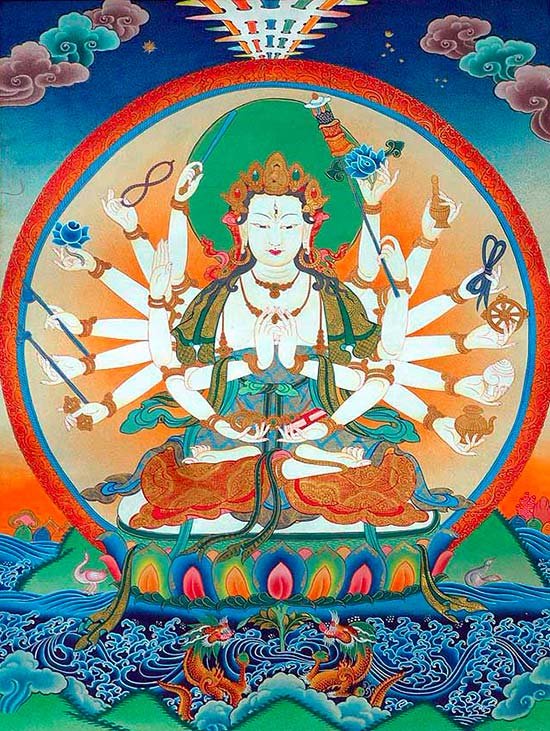Maha Prajnaparamita Sastra
by Gelongma Karma Migme Chödrön | 2001 | 941,039 words
This page describes “gaze like that of the elephant (nagavalokita)” as written by Nagarjuna in his Maha-prajnaparamita-sastra (lit. “the treatise on the great virtue of wisdom”) in the 2nd century. This book, written in five volumes, represents an encyclopedia on Buddhism as well as a commentary on the Pancavimsatisahasrika Prajnaparamita.
I. Gaze like that of the elephant (nāgāvalokita)
When one swivels one’s body and, in order to look, turns one’s whole body, this is “the gaze like that of the elephant” (nāgāvalokita).[1]
This is a mark of the Great Man (mahāpruṣalakṣaṇa). The body (kāya) and the mind (citta) are especially united; this is why, when one has something to look at, body and mind turn together. Thus when a lion has seized its prey, it is not because the latter is small that the lion is going to cool its ardor.[2]
It is the same for the Buddha. When he has something to look at or something to say, his body and his mind function together (yugapad vartante) and never are separate. Why? Because for incalculable periods (asaṃkhyeyakalpa), he has cultivated the faculty of attentiveness (ekacitta) and as a result of this action, the bone of his skull (mūrdhāsti) is but one with the body:[3] there is no separation between them.
Moreover, from lifetime to lifetime, the Buddha has eliminated pride (māna); this is why he does not scorn beings and when he looks at them, he turns completely towards them.
[Nīthāvadana].[4] – As it is said in the Ni-t’o-a-pa-t’o-na (Nīthāvadāna], Nītha was a street refuse-sweeper in the land of Śrāvastī and yet the Buddha patted his head with his hand and invited him to go forth from the world (pravrajitum); he was the only one who did not scorn him.
Footnotes and references:
[1]:
For anatomical reasons as well as out of politeness, the Buddha, “turning his whole body completely to the right, looks with the look of the elephant.” It is a time-honored expression: in Pāli, nāgāpalokitam apaloketi (Dīgha, II, p. 122, l. 4; Majjhima, I, p. 337, l. 3); in Sanskrit, dakṣiṇena sarvakāyena nāgāvalokitenāvalokayati (Sanskrit Mahāparinirvāṇa, p. 226; a fragment of the Madhyamāgama published by E. Waldscmidt, Teufeleien in Turfan-Sanskrittexten, 1976, p. 146, l. 13–15). In Tibetan: gyas phyogs su sku tams cad phyogs te bal glaṅ lta ba ltar gzigs.
The Chinese version of the Madhyamāgama (T 26, k. 30, p. 622a12) renders nāgāvalokita as long-che ‘dragon-nāga’, whereas it is a matter of ‘elephant-nāga’ (hastināga). The Commentary of the Majjhima, II, p. 420–421 explains: Yathā nāma hatthināgo ito vā etto vā apaloketukāmo gīvaṃ aparivattetvā sakalasarīren’ eva nivattitvā apaloketi, evaṃ sakalasrīren’ eva nivattītvā apalokesi. – Just as the elephant-nāga wishing to look around, does not turn its neck but swivels its entire body in order to look, so the Buddha turns his whole body to look.
[2]:
The Buddha swivels his whole body as easily as an ordinary person turns his neck. In the same way the lion is so powerful that it uses as much force to catch a small prey as a big one.
[3]:
The human body has 360 bones (asthi) according to the Aṣṭāṅgasaṃgraha, 3, 5, and Aṣṭāṅgahṛdaya, 3, 3; 300 bones according to the Suśruta, 3, 5. In Buddhas, they are fewer because many are fused together and the skull is joined to the trunk. Above (p. 278F, n. 1) we have seen that the Vibhāṣā recognizes only 103 bones in buddhas.
[4]:
See p. 1634F, n. 1.
